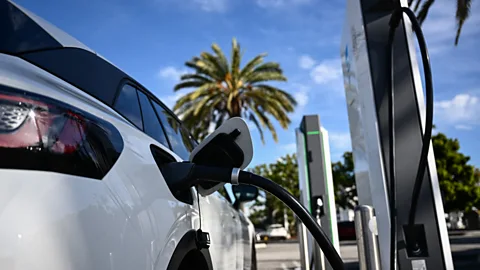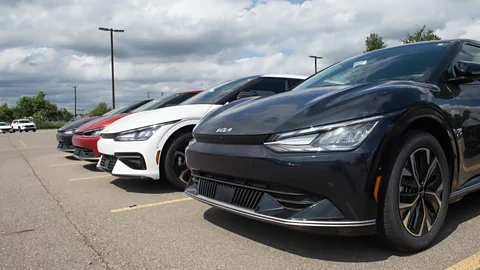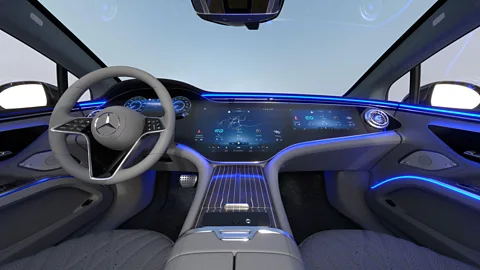Are US EV sales a disaster or a booming segment? The answer may be both
 Getty Images
Getty ImagesThere's a battle raging between electric vehicle naysayers and champions. Which group is right?
Globally, electric vehicles (EVs) are gaining traction. Markets are growing and drivers are hopping in. One of the biggest opportunities remains in the US. On one hand, EV sales are rising. On the other, however, an overwhelming segment of drivers are still reluctant to replace their internal-combustion engine (ICE) vehicles. Depending on how you look at it, the state of the US EV market is flourishing – or it's stuck in neutral.
While drivers in the US have been slow to adopt EVs in significant numbers, sales overall continue to increase. During the final quarter of 2023, EV sales in the US grew 40% year-over-year, according to data from Cox Automotive, with total sales of nearly 1.2 million vehicles. Additionally, the total EV market share in the US grew to 7.6% from 5.9% a year earlier. Individual automakers including Mercedes and Tesla reported strong numbers for the years. Mercedes EV sales increased 248% last year, and Tesla's sales were up 38%.
But despite these numbers, automakers have cut sales forecasts and limited EV production. Ford cut production plans for its F-150 Lightning – an electric version of its massively popular pickup truck – anticipating less growth in the market than expected. General Motors has also cut production goals, and even temporarily stopped selling a brand-new model, the Chevrolet Blazer EV, due to performance problems.
These kinds of conflicting factors have left consumers puzzled. Yet experts say that while the US EV market may be going through a rough patch, it's far from dead.
Reasons for doubt
In discussions about the viability of EVs in the US, the voices of pessimists are loud. They point to slow adoption, high price points and a lack of critical charging infrastructure as major hurdles to widespread market penetration that won't soon be solved. And the people who wanted these vehicles – the initial batch of consumers who helped propel early growth in the EV space – already have one. This scepticism is not entirely off-base.
 Getty Images
Getty ImagesFor one, even though updating and expanding charging infrastructure is getting a boost from both public and private initiatives, the movement is slow and expensive. "Here's the problem with electrification: it's a governmental and environmental initiative, not a consumer agenda," says Joe McCabe, president and CEO of AutoForecast Solutions, a company that works with part suppliers and auto manufacturers. That leaves the future of infrastructure in the hands of a small group of decision makers – which means drivers are on someone else's timeline.
Loren McDonald, CEO of the analyst firm EVAdoption, believes much of the recent pessimism surrounding EVs is also due in part to automakers slashing their production targets. "This was all about Ford and GM," he says. "Look at the op-eds. They all started when Ford and GM said they were slowing down and cutting production."
In addition to resetting expectations around growth, there are other hurdles that EV makers and dealers need to contend with when trying to move EVs off of the sales lot. For one, EVs are quickly becoming a political issue during a US presidential election year. Additionally, some states are raising barriers to adoption. Texas recently started imposing high registration fees on EVs – $400 (£315) at the time of purchase, and $200 (£158) annually for renewal – and other states are following suit.
Legislators in Wyoming have also put forth a proposed law that would ban EV sales outright to protect the fossil fuel industry. "Phasing out the sale of new electric vehicles in Wyoming by 2035 will ensure the stability of Wyoming's oil and gas industry and will help preserve the country's critical minerals for vital purposes," according to the text of the legislation.
Some experts say many of these barriers will come down. In the immediate, however, these factors can make buyers second-guess an EV purchase, and instead opt for an ICE or hybrid vehicle instead. "The shift is significant" for drivers, says Schirmer. Buying an EV is "way harder than buying another Toyota Camry".
'It's a large, slow-moving operation'
There are plenty of optimists, however, who are pushing back on the doom-and-gloom narrative. They say pessimists are short-sighted, and that the EV market is already doing well – and will do better in years to come.
"There's a lot to unpack," says McDonald. "This was, from a sales volume perspective, the best year ever – near 50% year over year growth, and if you look at that growth increase, that volume was more than the entire number of EVs sold just two or three years ago."
McCabe says there's plenty of growth ahead in both sales volume and market share – but it will be solid and steady, not explosive as originally (and incorrectly) forecasted. EVs are still in growth mode, and they believe consumers, investors and automakers simply need to reset their expectations.
This is especially because the auto market changes at a glacial pace. "One of the things to recognise is that the automotive industry in the US is 120 years old, it's a large, slow-moving operation," says Mark Schirmer, director of industry insights and corporate communications at Cox Automotive. "There are 16 million new vehicles sold each year, and there are roughly 270 million vehicles on the road in the US."
 Alamy
AlamyMany people who own those vehicles aren't going to run out and buy a new car – let alone a new EV – simply because there's something different on the market. As such, he says it'll take time for the market to adjust. "You can't expect 50% growth year-over-year every year," says Schirmer. "It's a fair statement to say that there were mismatched expectations."
'Too big to fail'
Ultimately, the reality of the EV market isn't so black and white. There's a lot of nuance to the industry – and pointing to encouraging sales figures or immediate challenges doesn't tell the whole story. Although it is fair to say that early predictions and expectations were outsized, and in some cases, flat-out wrong, many experts believe the market will eventually boom – it'll just take a while.
Schirmer believes "there will be a long-term shift in which, each year, the number of EVs on the road continues to increase". He says it's not unreasonable to think that within a few years, the US will see overall EV market share climb into the "low teens" from where it is now – effectively doubling.
McDonald thinks automakers will also learn more about their consumers and the market for EVs in the US and adjust accordingly. He says that Ford and GM may have miscalculated when they leaned into expensive electric trucks and luxury models, which may be why the two companies overestimated EV demand. "There's only so many people ready to buy electric trucks, and most of them are not traditional truck-buyers," he says.
And with the money already invested in research and development, production and building out the infrastructure for EVs, it would probably be a bad bet to wager against the long-term viability of the EV market. "There's trillions of dollars tied up in it," says McCabe. Manufacturing EVs is "a too-big-to-fail proposition".
